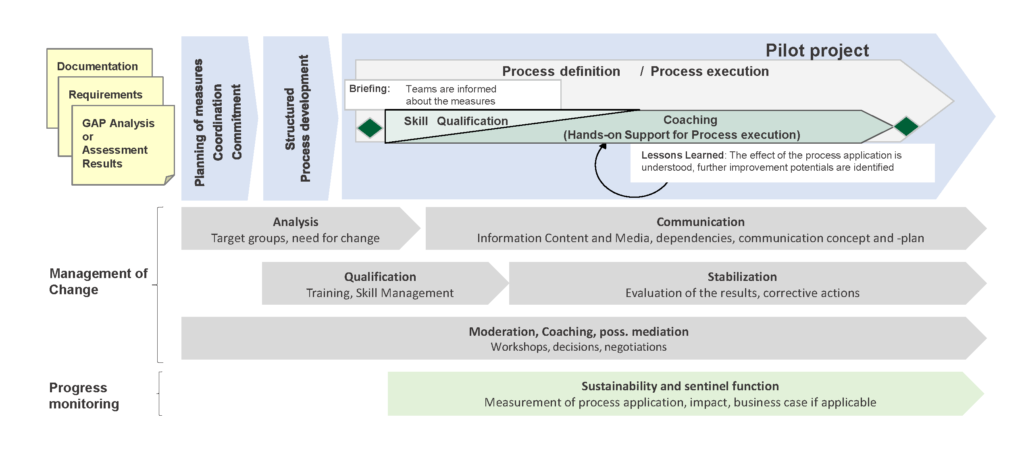Basic approach to consulting projects
1. Success factors
The success of process improvement activities is significantly influenced by the following factors:
- Good and regular management support
- Regular direct communication from management to the working level (continuously visible!)
- Early coordination of interfaces between processes
- Development of lean and purposeful processes that simplify work
- Close cooperation between technical experts (client) and process experts (contractor, quality team)
- Prompt practical testing with lessons learned and feedback loop
- Regular progress control, reporting and adjustment (project and change management)
- Quality assurance during the introduction of the processes (piloting / rollout / regular control)

2. Structured development of lean and accepted processes
Based on the GAP analysis report, an action plan is defined to close the identified gaps. For each weakness, the required activity is defined.
For process improvement, we focus on simple and straightforward processes with high acceptance. The key to successful process improvement is collaboration between the subject matter experts and the process experts. We have developed a 5-step method to ensure the right environment for process improvement and the step-by-step development and implementation of the development process.
- Setup
- Define goals and motivation
- Analyze strengths and potentials
- Define milestones for improvement goals
- Set up process infrastructure (e.g., roles such as process sponsor, process manager, process owners, process champions)
- Involve stakeholders and team in the kick-off
- define and agree on processes step by step
Step 1: Define and agree on the purpose and key work products.
Criteria: Purpose defined for each process. Major work products specified according to content and dependencies. Approved by the process owner.
Step 2: Definition and agreement of roles and responsibilities.
Criteria: Name and purpose of roles are defined. Responsibilities (owner, supporter, approver) are assigned to each work product. Sequence of activities is designed. Approved by the process owner.
Step 3: Define and agree on activities.
Criteria: Name and bullet points for each activity are defined. Approved by the process owner.
Step 4: Define and agree on templates and checklists.
Criteria: A template or checklist is defined for each work product. Approved by the process owner.
Step 5: Define and agree on work instructions, methods, etc.
Criteria: Additional information for performing the process is defined. Approved by the process owner.

3. Piloting, continuous process improvement and management of change
Every change program means real change for the organization concerned. In addition to classic project management, systematic change management is required in the program and outside the projects in the line organization in order to anchor the results and sustainably achieve the set goals.
The introduction of new processes and thus the introduction of ASPICE®-compliant work chains forces new work processes to be anchored in the company in the long term. This requires cultural changes in the departments in order to achieve better quality in product development through the use of standardized processes. The necessary measures for change and anchoring in the development organization are time-consuming and, depending on the size of the organization, usually extend over a period of several years. This means that the change management aspect is of far-reaching importance.
Among other things, the success of process change programs also depends very much on consciously establishing practices that focus on people and support them in the change process, such as:
- Create clear project assignments
- Clearly define and distribute roles and tasks within the organization and the departments involved
- Derive optimization targets from the current business situation
- Anchor necessary changes in the target agreements
- Provide incentives for process improvements
- Create a sense of achievement by demonstrating the benefits of the changes introduced with regular performance measurements of the defined sub-goals
- Involve affected process users in process design so that experts from the respective domains define “their” processes as characteristics of later standard processes and thus prepare them for piloting and rollout.
- Apply principles of systems engineering to process management as well
We recommend designing the process improvement program based on our proven process improvement model (see Figure 1).

Figure 1: Process improvement model

Alexander Mackert
Principal Consultant & CEO
Consulting Quotation
Our team has a lot of international experience and has offices in Germany, India and China. Get in touch with us and request a quote for Automotive SPICE® Consulting.
We are also happy to accompany you on your journey to the targeted competence level through pre-assessment and improvement workshops .


